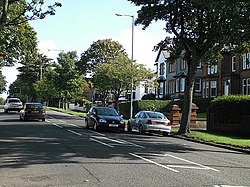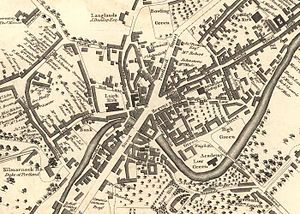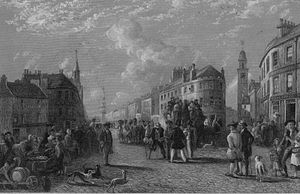Kilmarnock
| Kilmarnock | |
| Ayrshire | |
|---|---|
 Glasgow Road, Kilmarnock | |
| Location | |
| Grid reference: | NS429381 |
| Location: | 55°36’40"N, 4°29’45"W |
| Data | |
| Population: | 44,734 |
| Post town: | Kilmarnock |
| Postcode: | KA1-KA3 |
| Dialling code: | 01563 |
| Local Government | |
| Council: | East Ayrshire |
| Parliamentary constituency: |
Kilmarnock and Loudoun |
Kilmarnock is a large burgh in Ayrshire, halfway between Glasgow and Ayr. The River Irvine runs through its eastern section, and the Kilmarnock Water passes through it, whose riverbank names 'Bank Street' in the town.[1]
Churches
Kilmarnock has 12 Church of Scotland congregations, and some other denominations.
History

Kilmanock's name comes from the Gaelic cill (church), and Saint Marnoch or Mernoc who is also remembered in the name of Portmarnock in Ireland, and Inchmarnock.
The core of the early town appears to have lain around what is now the Laigh Kirk (Low Church), although the oldest parts of the current building are no earlier than the 17th century, extending north and northwest. In 1668 the town was largely destroyed by an accidental fire. About 120 families lost most of their possessions and were forced to live destitute in the fields surrounding the town, a second blow for the tradesmen of the burgh who had already been driven to the edge of poverty by having troops billeted with them as part of the anti-Covenanter measures. Parish churches throughout Scotland collected money for the relief of the homeless folk of Kilmarnock.[2]

The town remained a modest settlement until the industrial revolution. As the textile industries took hold from around 1800, Kilmarnock extended considerably, and formal, planned developments sprung up, such as King Street, Portland Street, Saint Marnock Street. John Finnie Street was built in the Victorian period, and is often suggested as one of the finest Victorian planned streets in Scotland.